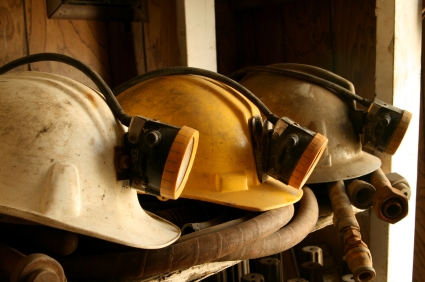Using National Stone Sand and Gravel Association Resources For Enhanced Safe Production For Employers
At the end of the day, a company's rules, regulations, policies, procedures and implementation programs are only really successful when they can clearly be seen and understood from the vantage point of the hourly, "boots-on-the-ground" workers.
As safety professionals in the mining industry, we recognize that the ability to provide shareholder equity and return on investment while delivering a product that meets both client and governmental agency specifications is both daunting and challenging. Yet, there is an adrenaline rush when we can meet customer delivery schedules and still keep the plant productive and safe. This goal requires not only expertise and demonstrated commitment from top management, but also throughout the organization all the way down to the "boots-on-the-ground" employees. It is evident that a process-oriented, people-focused approach is needed to ultimately meet the company's imperatives and expectations as set forth by its board of directors.
The opportunity for mining professionals to deliver on these goals relies on the integration of various industry resources that make it possible to promote consistency, uniformity and objectivity in a corporate environment. At the end of the day, a company's rules, regulations, policies, procedures and implementation programs are only really successful when they can clearly be seen and understood from the vantage point of the hourly, "boots-on-the-ground" workers. The process becomes the art and science of safe production for the company. This article outlines practical ways to use National Stone Sand and Gravel Association resources for enhanced safe production to impact all levels within the company — but especially the hourly workers.
At a Harvard Commencement Address in 2001, former U.S. Secretary of the Treasury Robert Rubin stated, "Individual decisions can be badly thought through and yet result in success, whereas, alternatively, exceedingly well thought-through decisions might result in a lack of success ... But, over time, more thoughtful decision making will lead to better results, and more thoughtful decision making can be encouraged by evaluating decisions on how well they were made rather than on outcome."
This idea speaks to the law of unintended consequences, and leads to the importance of governmental rulemaking and its impact on our hourly employees.
It is through national associations such as the National Stone Sand and Gravel Association and respective state associations with active health and safety committees and governmental affairs groups to monitor, recommend and involve themselves in grassroots and lobbying efforts that we ultimately impact the behaviors of all employees in an operation. Many companies have successfully involved their legal and corporate health and safety departments, as well. It is also the manner in which production reality and expertise of health and safety professionals are shared with operational employees — through design, rulemaking acumen and mutual appreciation — that can make safety rules advantageous or burdensome for the mine operator.
As of July 2011, the U.S. Mine Safety and Health Administration (MSHA) has 11 agenda items in various stages of rulemaking, with four proposed and one in a pre-rule stage specifically targeted to the metal/nonmetal sector. While the remaining items are oriented to the coal industry, they too are worth tracking to gain a better view of governance over the mining industry as a whole (sSee Agency Rule list below).
Unified Agenda Issued July 2011 (Spring Edition)
| Agency | Agenda Stage | Title Of Rulemaking |
| DOL/MSHA | Pre-rule | Safety and Health Management Programs for Mines |
| Proposed | Respirable Crystalline Silica Standard | |
| Proposed | Lowering Miners' Exposure to Coal Mine Dust, including Continuous Personal Dust Monitors | |
| Proposed | Proximity Detection Systems for Underground Mines | |
| Proposed | Notification of Legal Identity | |
| Proposed | Criteria and Procedures for Proposed Assessment of Civil Penalties | |
| Proposed | Pattern of Violations | |
| Proposed | Examination of Work Areas in Underground Coal Mines for Violation of Mandatory Health or Safety Standards | |
| Final | Maintenance of Incombustible Content of Rock Dust in Underground Coal Mines | |
| Long-Term Actions | Revisiting Electrical Product Approval Regulations | |
| Completed Actions | Metal and Nonmetal Dams |
Teamwork through the National Stone Sand and Gravel Association's Alliance with the U.S. Mine Safety and Health Administration helps with evaluating proposed rules. The National Stone Sand and Gravel Association's President and CEO Joy Wilson originally signed the alliance with the U.S. Mine Safety and Health Administration in February 2003. The date is significant because for the first time ever, the U.S. Mine Safety and Health Administration and an industry association jointly agreed to adopt health and safety performance goals with objective measures.
There is one key phrase in the agreement that truly sums up this pact: "We need a culture of prevention." With the renewal of the alliance in October 2010, both the National Stone Sand and Gravel Association and the U.S. Mine Safety and Health Administration are working to promote a national dialogue on worker health and safety by sharing information on best practices and exploring effective approaches to eliminate mining hazards. Last year, the alliance integrated a technical task force to assist in rulemaking considerations. With outreach, the alliance conducts the dialogue of safe production through this technical task force — a subset of the alliance consisting of operational professionals responsible for execution of safe production on a day-to-day basis.
The combined efforts of senior management at the meetings — Neal Merrifield, the U.S. Mine Safety and Health Administration's administrator for metal/non-metal, and Past National Stone Sand and Gravel Association Chairman Louis Griesemer, president and CEO of Springfield Underground — along with operational and safety professionals has made for some lively discussions, to be sure, but it also has resulted in profitable dialogues.
Opportunities abound to make a difference for workers in aggregates facilities. The MSHA/NSSGA Alliance offers best management practices and materials such as the "Code of Safe Practices" for benchmarking or adaptation to one's own corporate culture. Other examples include "Safety Pro in a Box," intended to provide meaningful compliance assistance to new (or existing) operators in the aggregates industry, and "Core Principles of a Safety Program." The Alliance also has developed a series of training documents for pre-production safety meetings at mine sites, specifically designed for the "boots-on-the-ground" employees. Additionally, the "Rip & Share" safety handouts (produced in each issue of Stone, Sand & Gravel REVIEW magazine) were developed by a data mining team (comprised of representatives from U.S. Mine Safety and Health Administration and National Stone Sand and Gravel Association member companies) that analyzed incidents at all metal/nonmetal mines. The "Rip & Share" features are aimed at helping mine employees identify and control the types of hazards that could potentially result in incidents and injuries at their mine sites.
There is one key phrase in the agreement that truly sums up this pact: "We need a culture of prevention."
Other important materials created to influence workers include the National Stone Sand and Gravel Association Safety Pledge, voluntarily signed by National Stone Sand and Gravel Association CEOs, which promises to reduce workplace injuries and illnesses at their operations, and the Occupational Health Program (OHP) developed by the National Stone Sand and Gravel Association's Health and Safety Committee.
The Occupational Health Program actually was created and made available to member companies far in advance of any U.S. Mine Safety and Health Administration rulemaking. It reinforces a healthy workplace for employees through the design, application and implementation of practices that minimize occupational health hazards in the workplace (noise, dust, fumes, mists). It also provides a sensible, thoughtful process to help an organization's management team evaluate ways in which operational decisions are made that result in favorable outcomes. These can be measured by such "dashboard" indicators as citations, citation frequency, injuries and their levels of severity, workers' compensation claims, training and morale surveys. Topics such as crystalline silica are specifically covered. And given the anticipated Occupational Safety & Health Administration rulemaking on crystalline silica, the foresight of the Health and Safety Committee in having delivered the Occupational Health Program, which showcases proper decision making based on factual data, should help to boost health and minimize corporate liability. This easily adapted program also complements the National Stone Sand and Gravel Association's "Mineral Definition and Identification Guide," which is another tool to educate workers in identifying and engineering best management practices for reduction in occupational exposures.
Even with the integration of the proposed rulemaking, industry best management practices and programs, collaboration with state associations and National Stone Sand and Gravel Association active membership, the application of new ways to influence, educate, train and deliver safe production knowledge and techniques is a continuing primary focus for our workers. It is these workers who are the ones making the rock products, overseeing plant delivery systems and delivering the outcome by which CEOs are measured by their boards.
The moral to this story might imply that boards of directors typically assume good outcomes are the result of good processes and bad outcomes, therefore, result from bad processes. Author Nassim Nicholas Taleb has stated that the quality of a decision cannot be solely judged by its outcome. A strategy must be judged as good or poor prior to the known outcome. And those who judge decision quality solely on outcome are often confusing skill and luck. To reiterate from Rubin's commencement address, "... over time, more thoughtful decision making will lead to better results, and more thoughtful decision-making can be encouraged by evaluating decisions on how well they were made rather than on outcome."
Even with emphasis on health and safety programs, policies, rewards, discipline and creation of a safe production "culture" in our industry, it is our miners who are our success. How do we achieve success? We achieve it through employee acknowledgement, involvement and ownership in the process. Success is borne of changing the corporate mindset to focus on the "willing miner" — the idea that people want to do a good job and take pride in their work and they do not want to get hurt — rather than approaching employees as resistant or looking to "bail out." In the end, this mindset makes it easier for folks to work better and more safely.
Take the opportunity to look at the operation from the "boots-on-the-ground" miner's perspective as they perform the decision-making process day to day. It is the true basis and checkpoint for thoughtful decision making that ultimately leads to better results for the company and CEO's dashboard for success.





